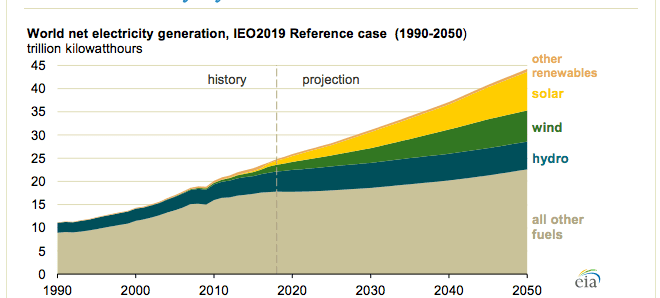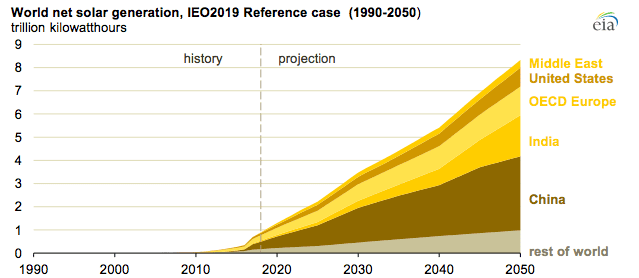EIA: Renewables Will Account for Half of Global Power Generation by 2050
The post EIA: Renewables Will Account for Half of Global Power Generation by 2050 appeared first on POWER Magazine.
Solar power is expected to take a larger share of global power generation across the next 30 years, according to the U.S. Energy Information Administration (EIA), as renewable energy continues to be adopted worldwide.
The EIA's International Energy Outlook 2019 (IEO2019), released Oct. 2, shows 28% of the world's power came from renewables in 2018, nearly all of that from wind, solar, and hydropower. The EIA forecasts that renewables will account for almost half-49%-of global electricity output by 2050, with solar generation showing the most growth, while hydro grows more slowly.

Source: U.S. Energy Information Administration, International Energy Outlook 2019
Solar and other renewables' growth is not limited to utilities or government efforts to expand the sector. Several companies are using renewables to power their commercial and industrial operations. Exxon Mobil, the oil giant which recently reported $20.8 billion in earnings in 2018, signed a 12-year deal with Danish energy company irsted late last year to purchase solar and wind power in West Texas. The electricity will power Exxon Mobil's operations in the Permian Basin.
Texas, in fact, leads the U.S. in electricity production from wind. Wind power production across the first half of 2019 eclipsed coal generation in Texas for the first time. Two large, utility-scale solar projects also were announced recently in the state, the Misae I and Misae II installations in Childress County that have about 1 GW of generation capacity.

Source: U.S. Energy Information Administration, International Energy Outlook 2019
Note: OECD is the Organization of Economic Cooperation and Development.
Julia Hamm, president and CEO of the Smart Electric Power Alliance, in an interview with POWER on Sept. 23 at North America Smart Energy Week (NASEW) in Salt Lake City, Utah, said business opportunities for utilities and others are a large part of the growth in renewables, including solar and energy storage, the focus of the NASEW event.
"We are helping utilities understand how [renewables] can be an opportunity," Hamm said. "We're working on how do we need to change the regulatory compact as to how do utilities make money. It's no longer just a commodity, selling kilowatt-hours. We talk to them about what new products and services they can offer, such as what are the opportunities for utilities for behind-the-meter storage, and what is going to resonate with consumers. And you have to look at the different needs for different electricity customers. We go from the big picture all the way down to specific opportunities for utilities."
Xcel Energy in Colorado recently announced a solar project in Pueblo that will power a steel mill, an industrial site which has long depended on a nearby coal-fired plant for its electricity. Xcel plans to close both units of the coal plant over the next five years.
EIA's IEO2019 report says, "Resource availability, renewable policies, regional load growth, and declining technology costs drive EIA's projected increase in global electricity generation from solar technologies. As more solar power systems have been installed, installation costs have experienced the steepest cost declines of all renewable technologies in recent years, and EIA expects that they will continue to decline as a result of learning-by-doing effects."
The report notes, "In many regions, solar resources are also generally more abundant than wind resources and typically follow very predictable daily and seasonal generation patterns. Resource availability and predictability and relatively simple plant construction technology also support favorable economics for solar photovoltaics, the most common solar generation technology in the IEO2019 Reference case."
EIA said it expects China will experience the greatest growth in solar power due to the country's increasing demand for electricity, along with government policies supporting solar, and that country's lower costs to manufacture solar technology. EIA said wind power has "significant growth potential," in part because many areas where wind power could be utilized are not yet developed. It cited India, and OECD (Organisation for Economic Co-operation and Development) Europe, as areas where wind power generation could grow.
The agency said hydropower "is a mature technology" and many of the best sites for hydro are already developed, though it noted Brazil, China, and OECD Europe as areas where more hydro could be sited.
-Darrell Proctor is a POWER associate editor (@DarrellProctor1, @POWERmagazine).
The post EIA: Renewables Will Account for Half of Global Power Generation by 2050 appeared first on POWER Magazine.